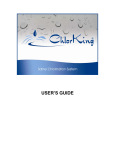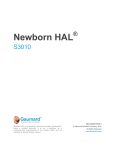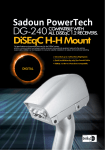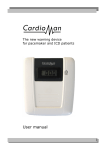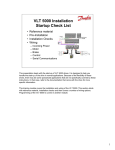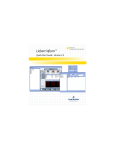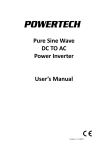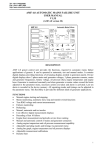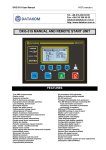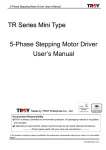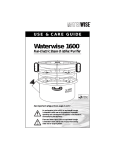Download “C” type Generator End User`s Manual Addendum For 15,17.5, 20
Transcript
“C” type Generator End User’s Manual Addendum For 15,17.5, 20 and 25kW gensets with “C” in third position in Serial Number Power Technology Southeast, Inc. 634 SR 44 W. Leesburg, FL 34748 800-760-0027 Fax: 352-787-5545 www.powertech-gen.com 1 Please read this manual carefully prior to installing and operating this generator. If you have any questions please feel free to contact us at 800-760-0027 or via our website at www.powertech-gen.com General Technical Data of the Generators • Synchronous brushless generator, single phase • Rated 22kW and 25kW,120/240V, 250/125Amps • 4-pole, 60Hz,1800RPM, PF=1.0, Continuous Duty • Temp rise 105°C / 50°C ambient temperature • Suitable for operation with VR3.1 • Insulation Class H • SAE 4, SAE 7 ½ • Single bearing The use of any spare parts that are not genuine or not expressly authorized shall free Power Technology Southeast, Inc. from any warranty liability and any responsibility concerning conformity to regulations and relevant consequences. Installation, after-sales modifications and maintenance must be carried out by adequately trained staff. 2 TABLE OF CONTENTS RULES FOR SAFE OPERATION ........................................................................................................................ 4 RECEIVING THE GENERATOR......................................................................................................................... 5 STORING THE GENERATOR ........................................................................................................................... 5 INSTALLATION ............................................................................................................................................... 6 LIFTING THE GENERATOR.......................................................................................................................... 6 LOCATION/ENVIRONMENT ....................................................................................................................... 6 MOUNTING GENERATOR TO ENGINE ....................................................................................................... 6 EARTH/GROUND THE GENERATOR ........................................................................................................... 6 OPERATION ................................................................................................................................................... 7 BEFORE STARTUP ...................................................................................................................................... 7 START-UP .................................................................................................................................................. 7 SHUTDOWN .............................................................................................................................................. 7 MAINTENANCE .............................................................................................................................................. 8 GENERAL MAINTENANCE .......................................................................................................................... 8 INSULATION RESISTANCE TEST ................................................................................................................. 8 DRYING OUT THE GENERATOR WINDINGS ............................................................................................... 8 TROUBLESHOOTING ...................................................................................................................................... 9 MECHANICAL ISSUES................................................................................................................................. 9 ELECTRICAL ISSUES.................................................................................................................................... 9 FLASHING THE FIELD ............................................................................................................................... 11 REPLACING THE RECTIFIED ASSEMBLY ................................................................................................... 11 AVR ADJUSTMENTS ................................................................................................................................. 11 RESISTANCE VALUES FOR WINDINGS ..................................................................................................... 11 APPENDIX A – EXPLODED VIEW .................................................................................................................. 12 APPENDIX B – SPARE PARTS LIST ................................................................................................................ 13 APPENDIX C – Wiring diagram for Single Phase Generator (4 LEADS)........................................................ 14 3 RULES FOR SAFE OPERATION ! ALWAYS check the machine for loosened threads, bolts, or other parts before starting. NEVER operate the generator in an explosive atmosphere or where fire could result. CAUTION! FAILURE TO FOLLOW INSTRUCTIONS IN THIS MANUAL MAY LEAD TO SERIOUS INJURY OR EVEN DEATH! THIS EQUIPMENT IS TO BE OPERATED BY TRAINED AND QUALIFIED PERSONNEL ONLY! THIS EQUIPMENT IS FOR INDUSTRIAL USE ONLY. The following safety guidelines should always be used when operating, servicing, or maintain the generator end. DO NOT operate or service this equipment before reading this entire manual. This equipment should not be operated by persons under 18 years of age. ALWAYS make sure generator installation is in accordance with electrical codes for your location. ALWAYS have a qualified electrician perform the generator wiring installation. NEVER operate this equipment without proper protective clothing, shatterproof glasses, steel toed boots and other protective devices. NEVER operate this equipment when not feeling well due to fatigue, illness or taking medicine. NEVER operate this equipment under the influence of drugs or alcohol. NEVER use accessories or attachments, which are not recommended by your local distributor or original manufacturer for this equipment. Manufacture does not assume responsibility for any accident due to equipment modifications. ALWAYS allow the generator to cool before performing service and maintenance functions. Contact with HOT components can cause serious burns. NEVER operate the generator in any enclosed or narrow area where free flow of the air is restricted. If the air flow is restricted it will cause serious damage to the generator or engine and may cause injury to people. The generator engine gives off DEADLY carbon monoxide gas. ALWAYS make sure generator is properly grounded. DO NOT place hands or fingers inside the generator when engine is running (generator is rotating). NEVER allow power cables or cords to lay in water or any other liquid. The electrical voltage required to operate the generator can cause severe injury or even death through physical contact with live circuits. Turn all circuit breakers OFF before performing maintenance on the generator. ALWAYS make sure that electrical circuits are properly grounded per the National Electrical Code (NEC) and local codes before operating generator. Severe injury or death by electrocution can result from operating an ungrounded generator. If the unit is sold internationally (outside USA), please make sure that grounding is done according to the local electrical code. ALWAYS store equipment properly when not being used. Equipment should be stored in a clean and dry location. 4 ! STORING THE GENERATOR DANGER! HAZARDOUS VOLTAGE. Voltage or current hazard sufficient to cause shock, burn, or death. Disconnect and loackout power before servicing. NEVER touch output terminals during operation. This is extremely dangerous. ALWAYS stop the machine and place the circuit breaker in the “OFF” position when contact with the output terminals is required. There exists the possibility of electrocution, electrical shock or burn, which can cause severe bodily harm or even death! Back feed to a utility system can cause electrocution and or property damage. DO NOT connect to any building's electrical system except through an approved device or after building main switch is opened. ALWAYS have a licensed electrician perform the installation. If the generator is not immediately used, it should be stored indoors in a clean and dry environment. If the generator is stored for an extended period of time, it should be cleaned and tested before operation. Also, check all bolts for tightness and examine the insulation on lead wires for chafing. NOTE: Wet windings should be thoroughly dried out before operation otherwise serious damage to the generator can result. Please see the Maintenance section of the User Manual on how to how to dry out the generator windings. RECEIVING THE GENERATOR Once the generator is received you should first examine it carefully for any damages during shipping and for missing parts. If there is shipping damage, then please make note of the damage with the carrier, and contact Power Technology Southeast, Inc. immediately. NOTE: Please note any damage with the carrier and be sure to note this damage on the Bill of Lading document. Take digital photos when available and be sure to properly document the damage. 5 INSTALLATION Check the generator thoroughly before starting installation. Make sure there is no damage during shipment or during storage. Perform the Insulation Resistance Test and dry out the generator windings if necessary. Check Maintenance Section of this Manual for additional instructions. LIFTING THE GENERATOR ! WARNING! THE GENERATOR LIFTING EYE IS DESIGNED FOR LIFTING THE GENERATOR ONLY. IT IS NOT DESIGNED TO USE TO LIFT THE GENERATOR AND ENGINE (GENERATOR SET). USING EQUIPMENT WITHOUT PROPER LOAD BEARING CAPACITY CAN CAUSE SEVERE INJURY AND DAMAGE. Do not lift single bearing generators without the rotor anchor bar securely fixed. Remove the rotor anchor bar only when attaching the generator to the engine. Lift the generator horizontally in order to prevent the rotor from slipping out. LOCATION/ENVIRONMENT Installation of the generator to the engine must be done in a location that is protected from moisture, dust, dirt, and harmful fumes. Generator intake and outlet air passages need to be unobstructed during generator operation. Please do not mount any obstructions that would restrict the airflow. The generator needs sufficient air circulation in order to provide proper cooling. Make sure that hot air from radiator or engine does not pass through the generator. Make sure the mounting surface (generator set base) has sufficient strength, rigidity, and uses the proper anti-vibration mounts in order to keep vibration and noise to a minimum. MOUNTING GENERATOR TO ENGINE Generator is mounted to the engine by the use of the generator coupling disc which fits perfectly into the recess on the engine flywheel. Holes on the coupling disc correspond to threaded holes on the engine’s flywheel. The coupling disc will mate with the prime mover’s flywheel so that concentricity is obtained. Coupling to Engine: 1. Make sure that the generator and engine are level. 2. Carefully pull out the main rotor assembly from the generator housing. Be careful not to damage the copper stator windings. 3. Make sure the generator coupling disc is flat against the engine flywheel and fits perfectly into the recess on the engine flywheel. Use appropriate bolts and hardened washers to mount the coupling disc to the engine flywheel. Tighten with calibrated torque wrench. Split type lock washers should NOT be used due to possible damage to coupling disc. 4. Mount generator housing over rotor and mount to engine housing. Check that the exciter rotor and exciter stator are aligned. 5. Mount the generator SAE housing to the engine housing. If bolted properly there should be no further alignment necessary. EARTH/GROUND THE GENERATOR The generator housing has to be connected to ground. If flexible anti-vibration mounts are used, then an earth conductor should be 6 connected in parallel to the base for proper grounding. Generator has an “earthing” bolt on the housing. ! WARNING! MAKE SURE THAT GENERATOR EARTHING/GROUNDING IS DONE PROPERLY. NOT DOING SO CAN CAUSE SHOCK AND EVEN DEATH. OPERATION BEFORE STARTUP The following steps are recommended prior to starting the generator for the first time: 1. Make sure generator and engine are level and bolted securely on a base. 2. Check visually for any foreign materials. 3. Make sure all nuts and bolts are tightened properly. 4. Check all connections against the wiring diagram – especially the generator lead wires. Make sure connections are tight and properly insulated. Vibration can cause connections to loosen, disconnect or rotate causing short circuits. 5. Make sure generator is grounded correctly using generator grounding bolt located on the housing. 6. Make sure fan screen is assembled on the bell housing. START-UP 1. Make sure generator is in no-load condition - disconnect generator output from load. This can be done by switching the circuit breaker in the OFF position or not connecting a load to the gen set terminals. 2. Remove field excitation wires (F-) and (F+) from AVR. (See the Automatic Voltage Regulator User Manual). 3. Check that that all engine start-up procedures have been followed. 4. Start engine and adjust engine speed initially between 60Hz to 62Hz (for 60Hz rated generator). Reference engine manual for how to adjust speed. 5. Using properly rated voltmeter check line-to-line and line-to-neutral residual voltages on generator terminal connections. Residual voltages will be much smaller than rated generator voltages. If voltages are unbalanced or not according to expected ratios, shut down the engine and re-check the wiring. 6. If voltages are correct (balanced), shut down the engine and connect exciter field wires (F-) and (F+) to AVR. (See the Automatic Voltage Regulator User Manual). 7. Start the engine again. Have voltmeter hooked up to generator terminal board and adjust voltage to the rated value (120V/240V) by rotating the AVR voltage adjust screw. (See the Automatic Voltage Regulator User Manual). 8. Once AVR is adjusted, check again all line-to-line and line-to-neutral voltages on generator terminal connections for proper voltage levels. 9. If voltage levels in Step 8 are correct, then shut down the engine, and close the main circuit breaker to the load. Start up engine with load applied. 10. Check generator speed (frequency) under load. Adjust as necessary. 11. It is recommended to apply different load levels for a few minutes (25% load, 50% load, 75% load, full load, and 110% load) to the generator and test voltage levels for proper adjustment and function. SHUTDOWN Shutdown varies based on the engine used. Please reference the engine User Manual for proper shut down procedures. 7 MAINTENANCE GENERAL MAINTENANCE Check generator windings for buildup of dirt, oil, or any other substances. If found, please remove rotor and clean. Make sure the generator windings are dry before assembling. Check generator intake and exhaust venting openings (bearing cover and bell housing screen) to ensure airflow is not obstructed. Clean as needed. Periodically check bearings for unusual operation. Unusual operation is defined by excessive vibrations, unusual noise, grease leaking, etc. Replace bearings if unusual operation determined. Before operation check the resistance of the stator winding by performing the Insulation Resistance Test. The reading should be greater than 2 MΩ otherwise drying out the windings will be necessary. DRYING OUT THE GENERATOR WINDINGS One or more of the following methods can be used to dry out the windings. Push hot air through the generator using heaters and blowers. Make sure the air can flow freely through the generator. Also, be careful not to overheat the windings which could cause permanent damage. Run the generator set unexcited by disconnecting the AVR terminals (open circuit) for 15 minutes. Oven dry the generator for up to 3 hours at 60°C-80°C temperature. Make sure to remove AVR during oven drying. Once the Insulation Resistance is raised to a level of greater than 2 MΩ then the generator can be put into service. INSULATION RESISTANCE TEST 1. Disconnect all electronic components, AVR, etc. 2. Short out the diodes on the rotating diode assembly. 3. Use a MegOhmMeter or Insulation Multimeter rated at least 500V and connect between an output lead terminal and ground, and later disconnect the lead wires from the terminal board and measure the resistance between lead wires and ground. 4. Measured value of insulation resistance for all windings to ground and between phases. Measured values should be greater than 2 MΩ. If not, then dry out the generator windings. 8 TROUBLESHOOTING MECHANICAL ISSUES SYMPTOM Generator Overheating Excessive Vibration / Noise CAUSE SOLUTION Air vents obstructed, preventing normal air flow required for cooling Check vents at rear bearing cover and fan intake air vent and make sure obstructions are removed. Load exceeds generator rated load Reduce the load on the generator to equal or below rated load listed on generator name plate. High ambient temperature Improve airflow to generator. Make sure that hot air is not recycled from generator or engine. High altitude Altitude reduces the rating and affects the cooling of generator. Reduce load of generator until overheating stops. Misalignment of coupling between generator and engine. Realign and tighten connection between coupling disc and engine flywheel, and generator housing and engine housing. Make sure correct grade bolts are used and are tightened to appropriate torque level using calibrated torque wrench. Faulty or damaged bearing Replace bearing. ELECTRICAL ISSUES SYMPTOM CAUSE Exciter stator output voltage too low to start AVR Generator will not excite, no voltage Loss of residual magnetism Faulty AVR Faulty diodes or rectifier assembly Disconnected or shorted exciter rotor or main rotor lead wires Damaged or burnt exciter rotor/stator, stator or rotor windings Check engine speed (RPM) No load voltage too low Incorrect or faulty wiring. AVR not adjusted correctly SOLUTION First try increasing the engine speed to 110% of rated RPM for a few seconds to see if excitation is achieved. If this does not work then Flash the Field to restore residual magnetism. Flash the Field to restore the residual magnetism. Adjust or replace AVR. See AVR Manual. Check diodes first. Then replace the faulty rectifier assembly. Check lead wires for short or disconnection and repair. Check windings (visual check, smell check), measure resistances and compare with the rated values. Replace faulty parts. Increase speed on engine slowly to increase voltage. Do not increase speed over 110% of rated RPM. Check wiring against the Generator Wiring Diagrams in the Appendix. Check wires for short and open connections. Calibrate AVR by adjusting the Voltage screw / potentiometer. See AVR Manual. 9 Damaged or burnt exciter rotor/stator, stator or rotor windings Check windings (visual check, smell check), measure resistances and compare with the rated values. Replace faulty parts. ELECTRICAL ISSUES (continued) SYMPTOM CAUSE AVR not adjusted correctly Check engine speed (RPM) No load voltage too high Voltage below nominal, under load Check wiring against the Generator Wiring Diagrams in the Appendix. Check wires for short and open connections. Faulty AVR Adjust or replace AVR. See AVR Manual. AVR not adjusted correctly Calibrate AVR by adjusting the Voltage screw / potentiometer. See AVR Manual. Current too high (excessive load) or speed below nominal Reduce load and make sure current does not exceed rated current. Faulty AVR Adjust or replace AVR. See AVR Manual. AVR not adjusted correctly Faulty AVR Non-uniform rotation of engine Unstable voltage Calibrate AVR by adjusting the Voltage screw / potentiometer. See AVR Manual. Decrease speed until rated voltage is achieved. Rated voltage is listed on generator name plate. Incorrect or faulty wiring Faulty diodes Voltage above nominal, under load SOLUTION Misalignment of generator and engine. AVR is unstable Check the diodes. Replace the rectifier assembly. Calibrate AVR by adjusting the Voltage screw / potentiometer. See AVR Manual. Adjust or replace AVR. See AVR Manual. Check for uniform rotation of engine. Engine could be at fault. Check with engine User Manual or manufacturer for further troubleshooting. Check for mounting of rotor and stator on engine. Check that air gap is even on all sides. Re-mount rotor and generator housing on engine. Calibrate AVR by adjusting the Stability control screw (potentiometer) on AVR. See AVR Manual. 10 SERVICE FLASHING THE FIELD 8. Put back on the rear bearing cover. Residual magnetism of the exciter stator may be lost or weakened if the generator is not operated for long periods of time, during long periods of transport, or due to other situations. AVR ADJUSTMENTS While flashing the field, the generator MUST BE out of operation. Steps to flashing the field 1. Make sure the generator is not in operation (not rotating) and all terminals disconnected. 2. Disconnect exciter stator leads F+ and F- from the AVR. 3. Connect 12V DC battery to terminals F+ and F-, making sure that the (+) pole of the 12V DC battery is connected to F+ and (-) pole connected to F-. 4. Connect battery leads for approximately 3 to 5 seconds and then disconnect from F+ and F-. 5. Reconnect the F+ and F- to AVR. 6. Start the engine and run at rated RPM, with no load and check voltages. 7. Re-flash the field if generator voltage does not build up to rated values. REPLACING THE RECTIFIED ASSEMBLY 1. Disconnect the exciter stator leads F+ and F- from AVR. 2. Remove the rear bearing cover. 3. Remove the bearing from the shaft. 4. Disconnect all the wires to the rectifier assembly. 5. Remove rectifier assembly. 6. Replace with new or repaired rectifier assembly. Lock the screws with thread adhesive and reconnect all the wires. 7. Mount the bearing on the shaft. Adjustments on the AVR include screws / potentiometers that can adjust voltage and stability. Voltage Adjustment - Change the output voltage by adjusting the Voltage potentiometer screw on the AVR. Make sure generator is rotating at rated RPM. Turn clockwise to increase voltage and counter clockwise to reduce voltage. See AVR manual for additional instructions. Stability Adjustment – Change the stability of the generator by adjusting the Stability potentiometer screw on the AVR. Turn clockwise to increase stability and counter clockwise to reduce stability. See AVR manual for additional instructions. RESISTANCE VALUES FOR WINDINGS Rating (kW) 20 Stator U1-U2 (mΩ) 60 Rotor (Ω) 1.03 Exciter Exciter Stator Rotor (Ω) (mΩ) 18 126 22 60 0.9 18 130 25 47 1.0 18 130 11 1CB Series User Manual APPENDIX A – EXPLODED VIEW 16 17 19 18 20 10 4 3 9 8 7 11 1 12 13 14 5 2 6 15 Reference Number 1 2 3 4 5 6 7 8 9 10 Part Name Bearing cover Exciter stator Exciter stator lead wires Bolts for exciter stator Generator housing Generator mounting feet Stator Terminal lead wires (4 leads) Bearing Rectifier assembly Reference Number 11 12 13 14 15 16 17 18 19 20 Part Name Exciter rotor Main rotor Fan Coupling disc Bolts for coupling disc Automatic Voltage Regulator (AVR) Terminal board Base for AVR and Terminal board Control box cover Control box 12 1CB Series User Manual APPENDIX B – SPARE PARTS LIST Reference Number 1 2 3 4 5 6 7 8 9 10 11 12 13 14 15 16 17 18 19 20 Part Name Bearing cover Exciter stator Exciter stator lead wires Bolts for exciter stator Generator housing Generator mounting feet Stator Terminal lead wires (4 – 12 leads) Bearing Rectifier assembly Exciter rotor Main rotor Fan Coupling disc Bolts for coupling disc Automatic Voltage Regulator Terminal board Base for AVR and Terminal board Control box Control box cover Part Number *1CB-xx-001-00 *1CB-xx-002-00 N/A N/A N/A N/A N/A N/A *1CB-xx-009-00 *1CB-xx-010-00 *1CB-xx-011-00 *1CB-xx-012-00 *1CB-xx-013-00 N/A N/A VR3.1-00UL 1CB-TB-00UL N/A *1CB-xx-019-00 N/A * “-xx-“ –Insert kW rating for generator to complete Part Number. For example, Exciter Stator for 25kW generator is 1CB-25-002-00. 13 1CB Series User Manual APPENDIX C – Wiring diagram for Single Phase Generator 14 1CB Series User Manual 15

















